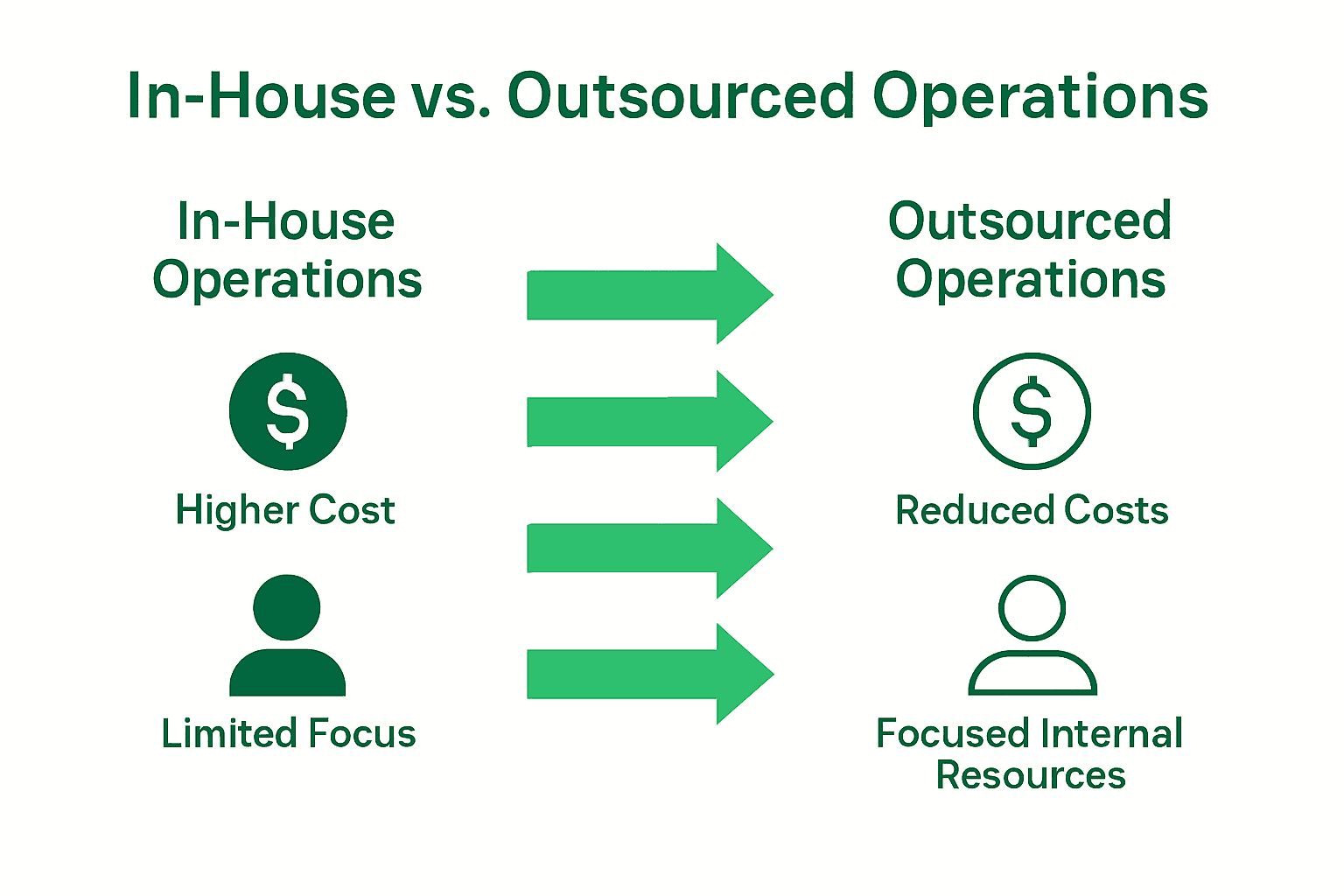Most organizations face growing pressure to do more with less, and outsourcing has become a powerful answer to this challenge. Studies show that businesses using strategic outsourcing can achieve up to 30 percent greater operational efficiency compared to those handling everything in-house. By turning to specialized service providers, companies unlock new growth opportunities while streamlining costs and complexity. This guide lays out how outsourcing supports business efficiency, explores solution types, and unpacks the real advantages and considerations for modern firms.
Defining Business Efficiency via Outsourcing
Business efficiency via outsourcing represents a strategic approach where organizations intentionally transfer specific operational tasks or functions to external specialized service providers. At its core, this methodology aims to optimize organizational performance by strategically allocating resources, reducing operational complexity, and focusing internal talent on core business objectives. Why Outsource Non-Core Functions: Complete Guide provides deeper insights into this transformative business strategy.
Understanding business efficiency through outsourcing involves recognizing how external partnerships can dramatically enhance organizational productivity. According to academic research, logistics outsourcing coupled with advanced information and communication technologies can significantly improve adaptability and overall organizational performance. The fundamental premise is simple: by delegating non-core functions to specialized providers, companies can concentrate their internal resources on innovation, strategic planning, and primary business growth.
The mechanics of business efficiency via outsourcing typically involve several key strategic considerations:
- Function Identification: Carefully selecting which business processes are suitable for external management
- Provider Evaluation: Thoroughly assessing potential outsourcing partners based on expertise, reliability, and alignment with organizational goals
- Performance Metrics: Establishing clear key performance indicators (KPIs) to measure the effectiveness of outsourced functions
- Cost-Benefit Analysis: Calculating potential savings and efficiency gains against investment and potential risks
Successful implementation requires a nuanced understanding that outsourcing is not merely a cost-cutting measure, but a sophisticated strategy for organizational transformation. By leveraging external expertise, businesses can access specialized skills, reduce operational overhead, and create more agile, responsive organizational structures. Outsource Repetitive Tasks Guide for Seamless Efficiency offers comprehensive strategies for integrating this approach effectively.
Ultimately, business efficiency via outsourcing represents a powerful methodology for modern organizations seeking to optimize their operational capabilities. It demands strategic thinking, careful planning, and a commitment to continuous improvement and adaptation.
Types of Outsourcing Solutions Explained
Outsourcing solutions encompass a diverse range of strategic approaches that enable businesses to delegate specific operational functions to external specialized providers. These solutions are not one-size-fits-all but rather a sophisticated ecosystem of targeted services designed to enhance organizational efficiency. Complete Guide to Outsourcing Business Operations provides comprehensive insights into the intricate landscape of outsourcing strategies.
Based on contemporary research, outsourcing solutions can be categorized into several primary models, each addressing unique organizational needs and technological requirements. The two most prominent categories are Information Technology Outsourcing (ITO) and Business Process Outsourcing (BPO). ITO focuses on technological infrastructure and digital service management, while BPO targets specific operational processes like customer support, human resources, and financial administration.
Key types of outsourcing solutions include:
- Information Technology Outsourcing (ITO)
- Software development
- Network management
- Cybersecurity services
- Cloud infrastructure support
- Business Process Outsourcing (BPO)
- Customer service operations
- Financial and accounting services
- Human resources management
- Data entry and processing
- Knowledge Process Outsourcing (KPO)
- Research and analytics
- Legal process support
- Content creation and marketing
- Intellectual property services
- Strategic Outsourcing
- Long-term partnership models
- End-to-end business function management
- Innovation and transformation consulting
Moreover, organizations can choose between onshore, nearshore, and offshore outsourcing models, each offering distinct advantages in cost, communication, and operational flexibility. Outsourcing Non-Essential Tasks: Complete Guide offers deeper exploration of these strategic nuances.
Ultimately, selecting the right outsourcing solution requires a comprehensive understanding of your organization’s unique requirements, technological ecosystem, and strategic objectives. Successful implementation demands careful analysis, strategic planning, and a commitment to building collaborative, value-driven partnerships with external service providers.

Key Benefits for Mid-Size and Large Firms
Outsourcing offers transformative advantages for mid-size and large firms seeking to optimize their operational capabilities and strategic resources. These organizations face increasingly complex business landscapes that demand flexible, efficient approaches to managing diverse functional requirements. Key Benefits of Business Process Outsourcing Explained illuminates the strategic potential of these partnerships.
Research consistently demonstrates that strategic outsourcing provides mid-size and large firms with multiple critical advantages. Empirical studies highlight significant improvements in organizational efficiency, particularly through enhanced human resource management and productivity optimization. The most prominent benefits include:
- Cost Reduction
- Lower operational expenses
- Reduced infrastructure investments
- Minimized recruitment and training costs
- Flexible resource allocation
- Strategic Resource Optimization
- Focusing internal teams on core business objectives
- Access to specialized global talent
- Rapid scalability of operational capabilities
- Increased organizational agility
- Technological Advancement
- Immediate access to cutting-edge technologies
- Reduced technology implementation risks
- Continuous technological upgrades
- Enhanced digital transformation capabilities
- Operational Flexibility
- Rapid response to market changes
- Reduced operational complexity
- Simplified management structures
- Enhanced competitive positioning
Large enterprises particularly benefit from outsourcing’s ability to transform complex operational challenges into streamlined, efficient processes. By strategically delegating non-core functions, organizations can redirect significant resources toward innovation, strategic planning, and core business growth.
 7 Essential Outsourcing Best Practices for Success provides additional insights into maximizing these partnerships.
7 Essential Outsourcing Best Practices for Success provides additional insights into maximizing these partnerships.
Ultimately, successful outsourcing for mid-size and large firms requires a nuanced approach that balances strategic objectives, operational requirements, and long-term organizational vision. The most effective outsourcing strategies are those that view external partnerships not as mere cost-cutting measures, but as integral components of a dynamic, adaptive business ecosystem.
Implementation and Integration Processes
Successful outsourcing requires a structured and methodical approach to implementation and integration that goes far beyond simple task delegation. Organizations must develop comprehensive strategies that align external partnerships with internal operational frameworks, ensuring seamless collaboration and minimal disruption. 7 Essential Outsourcing Tips for Businesses provides critical guidance for navigating these complex transitions.
The implementation process typically involves a multi-stage approach that demands meticulous planning and strategic execution. Research highlights the importance of systematic resource allocation and careful staff management during outsourcing transitions. Key stages of successful implementation include:
- Initial Assessment
- Comprehensive organizational capability audit
- Identifying suitable functions for outsourcing
- Evaluating potential external partner capabilities
- Defining clear performance expectations
- Partner Selection
- Rigorous vendor screening processes
- Technical and cultural compatibility assessment
- Detailed contract negotiation
- Establishing communication protocols
- Transition Management
- Gradual function transfer methodology
- Robust knowledge transfer mechanisms
- Parallel operational support systems
- Continuous performance monitoring
- Integration Strategies
- Seamless technological infrastructure alignment
- Cross-functional team collaboration
- Standardized reporting frameworks
- Adaptive workflow design
Technological integration represents a critical component of successful outsourcing implementation. Organizations must invest in robust digital platforms that enable real-time collaboration, transparent communication, and synchronized operational processes. This requires careful selection of technological tools that can bridge potential communication and operational gaps between internal teams and external partners.
Ultimately, successful implementation is not a one-time event but an ongoing, dynamic process of continuous optimization. By maintaining flexible, adaptive approaches and prioritizing clear communication, organizations can transform outsourcing from a transactional engagement into a strategic, value-generating partnership that drives long-term organizational growth and innovation.
Risks, Costs, and Compliance Considerations
Navigating the complex landscape of outsourcing requires a comprehensive understanding of potential risks, associated costs, and critical compliance challenges that can significantly impact organizational performance. Businesses must approach outsourcing with a strategic, nuanced perspective that balances potential advantages against inherent vulnerabilities. 7 Essential Outsourcing Tips for Businesses offers critical insights into managing these intricate considerations.
The outsourcing productivity paradox represents a fundamental challenge for organizations, where potential efficiency gains can be offset by long-term organizational risks. Research highlights several critical areas of concern that demand careful strategic evaluation:
- Financial Risks
- Unexpected additional implementation costs
- Potential hidden expenditures
- Currency exchange rate fluctuations
- Long-term economic sustainability
- Operational Risks
- Potential loss of organizational control
- Quality consistency challenges
- Communication and coordination complexities
- Reduced internal skill development
- Compliance Considerations
- Data privacy and protection regulations
- International legal framework variations
- Intellectual property protection
- Industry-specific regulatory requirements
- Security Vulnerabilities
- Cybersecurity infrastructure risks
- Potential data breach scenarios
- Third-party vendor security assessments
- Confidentiality protocol management
Economic efficiency analysis reveals that successful outsourcing strategies require sophisticated risk mitigation approaches. Organizations must develop robust frameworks that incorporate comprehensive vendor screening, detailed contractual protections, and continuous performance monitoring. This involves creating multi-layered compliance mechanisms that address potential vulnerabilities while maintaining operational flexibility.
Ultimately, effective outsourcing is not about eliminating risks entirely but managing them strategically. By implementing comprehensive due diligence processes, maintaining transparent communication channels, and developing adaptive compliance protocols, businesses can transform potential challenges into opportunities for innovation and organizational growth.
Unlock True Business Efficiency with Expert Outsourcing Solutions
Struggling to balance core business growth with everyday operational demands can be overwhelming. The article highlights key challenges such as selecting the right functions to outsource, managing vendor relationships, and maintaining compliance while driving efficiency. If you seek to reduce costs, scale rapidly, and refocus your internal teams on innovation, strategic outsourcing through a reliable partner is essential.
NineArchs LLC specializes in addressing these pain points by offering tailored business process outsourcing, virtual assistance, and custom software development designed to boost productivity and streamline your workflows. With a focus on professionalism, scalability, and cost-effectiveness, we empower mid-size and large firms to turn outsourcing into a competitive advantage.
Discover how you can transform non-core functions into strategic growth opportunities today.

Ready to enhance your operational efficiency and access top global talent with confidence Visit our contact page now to start a conversation with our experienced team. Learn more about outsourcing solutions that align perfectly with your goals in our Outsource Repetitive Tasks Guide for Seamless Efficiency and explore how to Outsource Non-Essential Tasks: Complete Guide can redefine your business operations.
Frequently Asked Questions
What is business efficiency via outsourcing?
Business efficiency via outsourcing refers to the strategic approach where organizations delegate specific operational tasks to external specialized service providers. This helps optimize performance, focus on core business objectives, and reduce operational complexity.
What are the main types of outsourcing solutions?
The main types of outsourcing solutions include Information Technology Outsourcing (ITO), Business Process Outsourcing (BPO), Knowledge Process Outsourcing (KPO), and Strategic Outsourcing, catering to different operational needs and requirements.
What are some key benefits of outsourcing for mid-size and large firms?
Outsourcing can significantly reduce costs, optimize resources, provide access to advanced technology, and enhance operational flexibility, allowing mid-size and large firms to allocate resources towards core business activities and innovation.
How can organizations effectively implement outsourcing?
Effective outsourcing implementation involves a structured approach that includes initial assessments, careful partner selection, transition management, and integration strategies to ensure seamless collaboration with external service providers.









